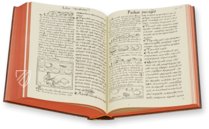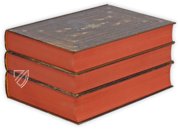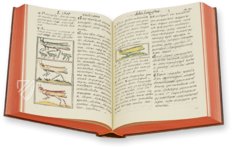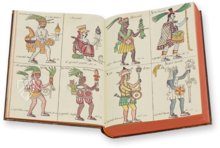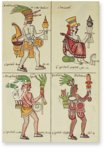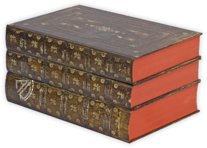Bernardino da Sahagún: Historia Universal de las cosas de Nueva España
(3,000€ - 7,000€)
"One of the most remarkable accounts of a non-Western culture ever composed": La Historia Universal de las Cosas de Nueva España (The Universal History of the Things of New Spain) by Bernardino da Sahagún. Considered to be the father of American ethnography, the Franciscan friar Bernardino da Sahagún created a work over the course of 45 years that spans 12 volumes and 2,400 pages, adorned with 2,500 illustrations by his indigenous assistants, who blended the aesthetics of Europe and Old Mexico. Sahagún was sympathetic to the local populace and wanted to learn as much about their culture and worldview as possible, which he could then record for the edification of other missionaries. This is an incredible source of incomparable worth concerning the Aztecs and other Mexican ethnicities, as well as a foundational work of both anthropology and ethnography.
Bernardino da Sahagún: Historia Universal de las cosas de Nueva España
Between the years 1545 and 1590, the Spanish Franciscan friar Bernardino de Sahagún (ca. 1499–1590) worked on one of the most important ethnographic research projects in history. Commonly referred to as the Codex Florentinus, referring to the most well-preserved specimen, which is housed in the Laurentian Library of Florence, it was originally titled: La Historia Universal de las Cosas de Nueva España (The Universal History of the Things of New Spain). It is a massive 12-volume, 2,400-page source spanning the worldview, rituals, society, economy, and natural history of the Aztec people. The work originated from a commission of Fray Francisco de Toral, the provincial superior of New Spain, who desired a text that would be useful for the missionary project. Toral ordered Sahagún to formalize his study of the indigenous population. He was assisted in his work by a group of Nahuas, an indigenous ethnic group from Mexico and El Salvador, and the book is recorded in the Nahuatl language in addition to Spanish. The work, which took 45 years to create, took another 30 years for the Americans Charles E. Dibble and Arthur J. O. Anderson to translate into English. This is one of the most important documents with regard to the history of Central America and has been described as: "one of the most remarkable accounts of a non-Western culture ever composed."
“The First Anthropologist”
Although Bernardino de Sahagún journeyed to New Spain in 1529 with the purpose of missionizing the indigenous population, he is famous today for his ethnographic study, but also translated various biblical texts into Nahuatl including the Psalms and the Gospels. He was educated at the University of Salamanca in the Humanist tradition, where he joined the Order of the Friars Minor, and spent the last 61 years of his life in New Spain. There Sahagún helped to found the first institution of higher education in the Americas, the Colegio Imperial de Santa Cruz de Tlatelolco, which was founded in 1536 in modern Mexico City. During his various missions throughout rural Mexico, Sahagún became proficient in Nahuatl, allowing him a great deal of insight into the worldview of the Aztecs and other ethnic groups. Interviews of local leaders concerning their perspectives on the Conquest of Mexico between 1553 and 1555 were published as the twelfth volume of his magnum opus. Missionaries like Sahagún, who greatly sympathized with and accepted the full humanity of the indigenous people, were often under suspicion by colonial authorities and the more conservative Dominican Order, some even being accused of endorsing idolatry for their tolerance of the Indochristian mix of Christian and pagan art that was developing at the time. However, Sahagún’s Humanist inclinations helped liberate him of such Eurocentric prejudices, allowing him to create an accurate and reliable account.
An Epic Ethnographic Project
After conducting research for about 25 years, Sahagún spent about 15 years editing, translating, and copying his work. Concerned with the reliability of information, he interviewed people, including women, both individually and in groups. There is evidence in his writing that indicates that he was constantly evaluating and developing his own research, attempting to create a crude methodology. In doing so, Sahagún created a precursor to the formal methods of inquiry practiced by modern anthropologists and ethnographers. His Nahau assistants, in addition to their own language, spoke Latin and Spanish, and were given full credit by him for their contributions, most notably for the ca. 2,500 illustrations they created, which blend European and indigenous artistic elements. Some passages are transcriptions of statements given in interviews, others are sets of questions and answers relating to a specific topic, and some take the form of a narration or commentary. His work took the form of a medieval encyclopedia, which resembles more of a medieval “world book”, attempting to transmit a complete narrative of world history – the New World in this instance. Sahagún’s overall impression of Aztec culture was overwhelmingly positive, even if he was disgusted at their idolatry and some ongoing practices like human sacrifice. He also determined that the initial wave of mass conversions in Mexico had been largely superficial, and that a true conversion of the population would require a much greater understanding of the language and worldview of the local populace.
Codicology
- Alternative Titles
- Codice Fiorentino
Florentine Codex
Codex Florentinus
La Historia General de las Cosas de Nueva España
The Universal History of Things of New Spain
The General History of Things of New Spain
Historia Universal de las Cosas de Nueva España
Códice Florentino - Type
- Manuscript on paper
- Size / Format
- 3 volumes: 2,446 pages / 32.5 × 22.0 cm
- Origin
- Mexico
- Date
- 1576–1577
- Epochs
- Style
- Language
- Illustrations
- 2,468 mostly colored illustrations in various formats
- Content
- Catalan and Coatepec Nahuatl texts covering the worldview, rituals, society, economy, and natural history of the Aztec people
- Patron
- Fray Rodrigo de Soquera (Padre Comisario General of Franciscan Order)
- Artist / School
- Friar Bernardino da Sahagún (b. 1499) (author)
Bernardino da Sahagún: Historia Universal de las cosas de Nueva España
Jaguar Warrior
Aztec warfare was based in the Aztec religion and as such the primary purpose of battle was not to kill the enemy but to capture them for use in ritual sacrifices. This task was primarily assigned to elite soldiers in the Aztec army including the Jaguar warriors, so-called because they wore the pelt of the jaguar in battle. They did for two reasons, firstly because they believed it made them fight with the jaguar’s strength, secondly because the jaguar represented the god Tezcatlipoca.

Bernardino da Sahagún: Historia Universal de las cosas de Nueva España
Aztec Gods
This incredibly rare Mexican manuscript represents a precious testimonial to pre-Columbian Aztec culture and in this case, the Gods of the Aztecs. Under the direction of the Franciscan friar Bernardino de Sahagún, a team of indigenous artists working in the native tlacuilo tradition of hereditary scribe-painters created images like this miniature in four registers.
Each of the Gods is labelled and presented in profile, most wear elaborate headdresses while all are depicted wearing sandals, a tunic, and a long skirt in the fashion of the Aztec people. Coloring is minimal and aside from light shades of green and red, the team of artists depicted the figures’ skin tones with surprising realism and in various hues.
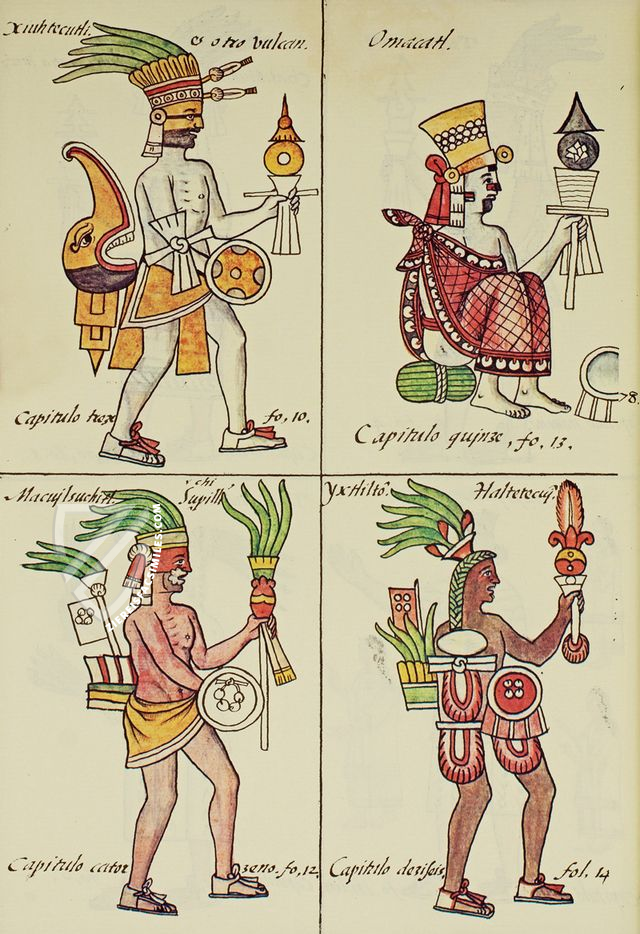
#1 Bernardino da Sahagún: Historia Universal de las cosas de Nueva España
Language: Italian
(3,000€ - 7,000€)
#2 Historia General de las Cosas de Nueva España
Language: Spanish
- Treatises / Secular Books
- Apocalypses / Beatus
- Astronomy / Astrology
- Bestiaries
- Bibles / Gospels
- Chronicles / History / Law
- Geography / Maps
- Saints' Lives
- Islam / Oriental
- Judaism / Hebrew
- Single Leaf Collections
- Leonardo da Vinci
- Literature / Poetry
- Liturgical Manuscripts
- Medicine / Botany / Alchemy
- Music
- Mythology / Prophecies
- Psalters
- Other Religious Books
- Games / Hunting
- Private Devotion Books
- Other Genres
- Afghanistan
- Armenia
- Austria
- Belgium
- Belize
- Bosnia and Herzegovina
- China
- Colombia
- Costa Rica
- Croatia
- Cyprus
- Czech Republic
- Denmark
- Egypt
- El Salvador
- Ethiopia
- France
- Germany
- Greece
- Guatemala
- Honduras
- Hungary
- India
- Iran
- Iraq
- Israel
- Italy
- Japan
- Jordan
- Kazakhstan
- Kyrgyzstan
- Lebanon
- Liechtenstein
- Luxembourg
- Mexico
- Morocco
- Netherlands
- Palestine
- Panama
- Peru
- Poland
- Portugal
- Romania
- Russia
- Serbia
- Spain
- Sri Lanka
- Sweden
- Switzerland
- Syria
- Tajikistan
- Turkey
- Turkmenistan
- Ukraine
- United Kingdom
- United States
- Uzbekistan
- Vatican City
- A. Oosthoek, van Holkema & Warendorf
- Aboca Museum
- Ajuntament de Valencia
- Akademie Verlag
- Akademische Druck- u. Verlagsanstalt (ADEVA)
- Aldo Ausilio Editore - Bottega d’Erasmo
- Alecto Historical Editions
- Alkuin Verlag
- Almqvist & Wiksell
- Amilcare Pizzi
- Andreas & Andreas Verlagsbuchhandlung
- Archa 90
- Archiv Verlag
- Archivi Edizioni
- Arnold Verlag
- ARS
- Ars Magna
- ArtCodex
- AyN Ediciones
- Azimuth Editions
- Badenia Verlag
- Bärenreiter-Verlag
- Belser Verlag
- Belser Verlag / WK Wertkontor
- Benziger Verlag
- Bernardinum Wydawnictwo
- BiblioGemma
- Biblioteca Apostolica Vaticana (Vaticanstadt, Vaticanstadt)
- Bibliotheca Palatina Faksimile Verlag
- Bibliotheca Rara
- Boydell & Brewer
- Bramante Edizioni
- Bredius Genootschap
- Brepols Publishers
- British Library
- C. Weckesser
- Caixa Catalunya
- Canesi
- CAPSA, Ars Scriptoria
- Caratzas Brothers, Publishers
- Carus Verlag
- Casamassima Libri
- Centrum Cartographie Verlag GmbH
- Chavane Verlag
- Christian Brandstätter Verlag
- Circulo Cientifico
- Club Bibliófilo Versol
- Club du Livre
- CM Editores
- Collegium Graphicum
- Collezione Apocrifa Da Vinci
- Comissão Nacional para as Comemorações dos Descobrimentos Portugueses
- Coron Verlag
- Corvina
- CTHS
- D. S. Brewer
- Damon
- De Agostini/UTET
- De Nederlandsche Boekhandel
- De Schutter
- Deuschle & Stemmle
- Deutscher Verlag für Kunstwissenschaft
- DIAMM
- Droz
- E. Schreiber Graphische Kunstanstalten
- Ediciones Boreal
- Ediciones Grial
- Ediclube
- Edições Inapa
- Edilan
- Editalia
- Edition Deuschle
- Edition Georg Popp
- Edition Leipzig
- Edition Libri Illustri
- Editiones Reales Sitios S. L.
- Éditions de l'Oiseau Lyre
- Editions Medicina Rara
- Editorial Casariego
- Editorial Mintzoa
- Editrice Antenore
- Editrice Velar
- Edizioni Edison
- Egeria, S.L.
- Eikon Editores
- Electa
- Emery Walker Limited
- Enciclopèdia Catalana
- Eos-Verlag
- Ephesus Publishing
- Ernst Battenberg
- Eugrammia Press
- Extraordinary Editions
- Fackelverlag
- Facsimila Art & Edition
- Facsimile Editions Ltd.
- Facsimilia Art & Edition Ebert KG
- Faksimile Verlag
- Feuermann Verlag
- Folger Shakespeare Library
- Franco Cosimo Panini Editore
- Friedrich Wittig Verlag
- Fundación Hullera Vasco-Leonesa
- G. Braziller
- Gabriele Mazzotta Editore
- Gebr. Mann Verlag
- Gesellschaft für graphische Industrie
- Getty Research Institute
- Giovanni Domenico de Rossi
- Giunti Editore
- Graffiti
- Grafica European Center of Fine Arts
- Guido Pressler
- Guillermo Blazquez
- Gustav Kiepenheuer
- H. N. Abrams
- Harrassowitz
- Harvard University Press
- Helikon
- Hendrickson Publishers
- Henning Oppermann
- Herder Verlag
- Hes & De Graaf Publishers
- Hoepli
- Holbein-Verlag
- Houghton Library
- Hugo Schmidt Verlag
- Idion Verlag
- Il Bulino, edizioni d'arte
- ILte
- Imago
- Insel Verlag
- Insel-Verlag Anton Kippenberger
- Instituto de Estudios Altoaragoneses
- Instituto Nacional de Antropología e Historia
- Introligatornia Budnik Jerzy
- Istituto dell'Enciclopedia Italiana - Treccani
- Istituto Ellenico di Studi Bizantini e Postbizantini
- Istituto Geografico De Agostini
- Istituto Poligrafico e Zecca dello Stato
- Italarte Art Establishments
- Jan Thorbecke Verlag
- Johnson Reprint Corporation
- Josef Stocker
- Josef Stocker-Schmid
- Jugoslavija
- Karl W. Hiersemann
- Kasper Straube
- Kaydeda Ediciones
- Kindler Verlag / Coron Verlag
- Kodansha International Ltd.
- Konrad Kölbl Verlag
- Kurt Wolff Verlag
- La Liberia dello Stato
- La Linea Editrice
- La Meta Editore
- Lambert Schneider
- Landeskreditbank Baden-Württemberg
- Leo S. Olschki
- Les Incunables
- Liber Artis
- Library of Congress
- Libreria Musicale Italiana
- Lichtdruck
- Lito Immagine Editore
- Lumen Artis
- Lund Humphries
- M. Moleiro Editor
- Maison des Sciences de l'homme et de la société de Poitiers
- Manuscriptum
- Martinus Nijhoff
- Maruzen-Yushodo Co. Ltd.
- MASA
- Massada Publishers
- McGraw-Hill
- Metropolitan Museum of Art
- Militos
- Millennium Liber
- Müller & Schindler
- Nahar - Stavit
- Nahar and Steimatzky
- National Library of Wales
- Neri Pozza
- Nova Charta
- Oceanum Verlag
- Odeon
- Orbis Mediaevalis
- Orbis Pictus
- Österreichische Staatsdruckerei
- Oxford University Press
- Pageant Books
- Parzellers Buchverlag
- Patrimonio Ediciones
- Pattloch Verlag
- PIAF
- Pieper Verlag
- Plon-Nourrit et cie
- Poligrafiche Bolis
- Presses Universitaires de Strasbourg
- Prestel Verlag
- Princeton University Press
- Prisma Verlag
- Priuli & Verlucca, editori
- Pro Sport Verlag
- Propyläen Verlag
- Pytheas Books
- Quaternio Verlag Luzern
- Reales Sitios
- Recht-Verlag
- Reichert Verlag
- Reichsdruckerei
- Reprint Verlag
- Riehn & Reusch
- Roberto Vattori Editore
- Rosenkilde and Bagger
- Roxburghe Club
- Salerno Editrice
- Saltellus Press
- Sandoz
- Sarajevo Svjetlost
- Schöck ArtPrint Kft.
- Schulsinger Brothers
- Scolar Press
- Scrinium
- Scripta Maneant
- Scriptorium
- Shazar
- Siloé, arte y bibliofilia
- SISMEL - Edizioni del Galluzzo
- Sociedad Mexicana de Antropología
- Société des Bibliophiles & Iconophiles de Belgique
- Soncin Publishing
- Sorli Ediciones
- Stainer and Bell
- Studer
- Styria Verlag
- Sumptibus Pragopress
- Szegedi Tudomànyegyetem
- Taberna Libraria
- Tarshish Books
- Taschen
- Tempus Libri
- Testimonio Compañía Editorial
- Thames and Hudson
- The Clear Vue Publishing Partnership Limited
- The Facsimile Codex
- The Folio Society
- The Marquess of Normanby
- The Richard III and Yorkist History Trust
- Tip.Le.Co
- TouchArt
- TREC Publishing House
- TRI Publishing Co.
- Trident Editore
- Tuliba Collection
- Typis Regiae Officinae Polygraphicae
- Union Verlag Berlin
- Universidad de Granada
- University of California Press
- University of Chicago Press
- Urs Graf
- Vallecchi
- Van Wijnen
- VCH, Acta Humaniora
- VDI Verlag
- VEB Deutscher Verlag für Musik
- Verlag Anton Pustet / Andreas Verlag
- Verlag Bibliophile Drucke Josef Stocker
- Verlag der Münchner Drucke
- Verlag für Regionalgeschichte
- Verlag Styria
- Vicent Garcia Editores
- W. Turnowski Ltd.
- W. Turnowsky
- Waanders Printers
- Wiener Mechitharisten-Congregation (Wien, Österreich)
- Wissenschaftliche Buchgesellschaft
- Wissenschaftliche Verlagsgesellschaft
- Wydawnictwo Dolnoslaskie
- Xuntanza Editorial
- Zakład Narodowy
- Zollikofer AG













